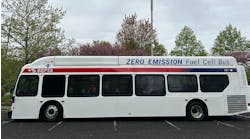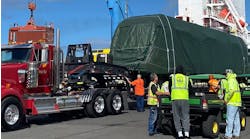Mar. 22—Central Texas leaders are hoping to revive the idea of a San Antonio-to- Austin passenger rail, more than seven years after a similar push fell apart.
At a regional transportation meeting Friday in San Marcos, San Antonio Council Member Melissa Cabello Havrda and Travis County Judge Andy Brown both pushed for including commuter rail as an option studies and plans for the Interstate 35 corridor.
"I'm very interested and have been talking a lot with some players about rail," Cabello Havrda said, mentioning Brown, Austin Mayor Kirk Watson and Bexar County Judge Peter Sakai. "We've had some lengthy discussions about the viability of it."
"It's time for a serious discussion on that as partners along that corridor," she said at the meeting for members of the Alamo Area Metropolitan Planning Organization and Capital Area Metropolitan Planning Organization — often called AAMPO and CAMPO — who were gathered for a joint executive committee meeting. The two agencies are responsible for regional transportation planning and allocating federal transportation funds.
Brown, the top official for Travis County, said he wanted to see passenger rail included in planning for the I-35 corridor, calling it "something that everyone from the chamber (of commerce) to transportation advocates in Travis County are really interested in."
"I have not heard anyone argue against this, either at the local or the state level, frankly, having better passenger rail transportation between the Travis County area and Bexar County area," he said.
Passenger rail has been a taboo topic in the region in recent years after the failure of the Lone Star Rail District, which was created by the state legislature in 1997, spent at least $25 million, then collapsed in 2016. That February, Union Pacific Railroad said it would not share its tracks, which it uses for hauling freight through the corridor, with commuter trains, killing the only feasible option, and CAMPO's board removed the proposed commuter rail line from its plans.
In the past year, conversations about rail have been revived, and the tones have changed.
Cabello Havrda said that while the energy in the room "did shift a little bit" when Lone Star Rail was mentioned, there was a softer reception than the last joint meeting when she brought up rail in June.
"For me, it was huge progress because nobody tried to shut it down," she told the Express-News after the meeting. That's been the case with conversations with Union Pacific as well, she said.
"What I will say about Union Pacific is they've having the discussions, they're taking my calls," Cabello Havrda said. The company has to keep its costs down and deliveries on time for freight customers, she said, but "if there's any middle ground to be found, it's going to be in these discussions and keeping an open mind."
She said government officials will need to look at other ideas, such as building rail in a different place or using elevevated railways along I-35.
Brown and Sakai also met with officials from Union Pacific in February and had "a wonderful conversation," Sakai told the Express-News — but that doesn't mean the company has changed its tune on sharing its tracks.
" Union Pacific has made it very clear that the freight rail on the lines that are currently used are very profitable and money-making to them and they want to make sure that any initiative does not impair or reduce their ability to make a profit on their rail lines," Sakai said. But he said he was "cautiously optimistic" that he and Brown were able to have a conversation with the company and "that they were willing to look at the options."
Cabello Havrda said she was also glad to see the discussion about rail come up during Friday's meeting before she spoke about it, when it was mentioned during a presentation by Heather Ashley-Nguyen, transportation planning and development director for the Texas Department of Transportation's Austin district.
TxDOT is working on a planning and environmental linkage study, and commuter rail has been brought up in public comments, Ashley-Nguyen said. The agency received 182 comments and had 116 attendees at open houses for the study, and rail was the second most common theme in comments, behind only highway congestion.
The study will focus on connecting the I-35 Capital Express project in Travis County to the I-35 Northeast Expansion project in Guadalupe County, northeast of San Antonio. Options that could be considered in the study include general-purpose lanes, truck-only lanes, high-occupancy vehicle lanes and transit or rail options, according to the presentation.
Council Member John Courage, who represents San Antonio's District 9, said he wanted to know more about what factors were being considered in the study, including time, cost and effects on economic development in the corridor.
"There are businesses today all along this route that would not want to see 50% of people just go right by and not stop for lunch or to stop or things like that because there's a rail line that will get them all the way to Dallas or all the way to Austin from San Antonio," he said. Courage said TxDOT should consider potential development, as well, and should ask "what kind of development might not take place if the rail line's just going to pass you by?"
"I'd love to see all of the inputs that are being put into this kind of planning to make sure that we're thinking about as much as we can and not just talking about how many billions of dollars we're going to spend on concrete and steel and asphalt," Courage said.
The cost of passenger remains the multi-billion-dollar question.
Williamson County Commissioner and CAMPO Chairwoman Cynthia Long said Lone Star Rail's fatal flaw was the lack of a funding mechanism.
Brown said he wanted to make it clear he isn't proposing a return to the Lone Star plans, and said current discussions are "very different," naming Amtrak and the Federal Railroad Administration as options for involvement.
"There are good conversations with all partners going on, there are some real funding mechanisms and I would just love to see that as part of the 2050 plan," he said.
Cabello Havrda urged the two planning agencies to consider the cost in the context of money being spent on other transportation projects.
While she's heard a previous price tag of $35 billion for commuter rail, "we're already spending $25 billion for land and road construction for what amounts to a total of 25 miles between San Antonio and Austin," she said, referring to highway projects on I-35. "We're not as far off as we think."
Sakai said he and Brown have also discussed possible federal funding sources, including the Biden administration's infrastructure act.
"We have many moving pieces that have to fall in line," he said.
Cabello Havrda said her next step is having a discussion at AAMPO about finding a way to fund a studies or plans for rail options.
"I don't expect that our efforts right now are going to bring rail to fruition in a year," she said, saying she'd like to seek input from people throughout the corridor, as well as working to get state officials on board.
Cabello Havrda said a push for commuter rail is not an attempt to replace all personal vehicles with trains. But she said: "I think that at this point we just can't afford to talk about our common future without talking about the option of rail."
___
(c)2024 the San Antonio Express-News
Visit the San Antonio Express-News at www.mysanantonio.com
Distributed by Tribune Content Agency, LLC.


